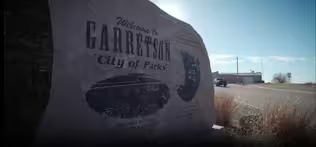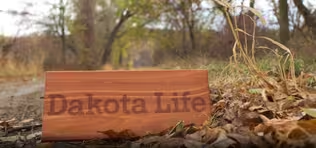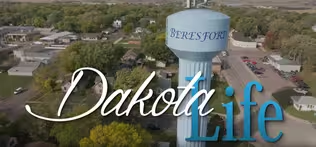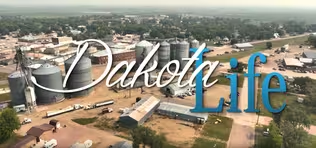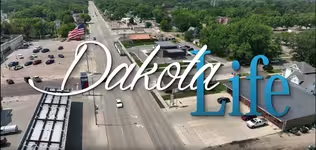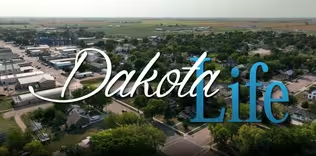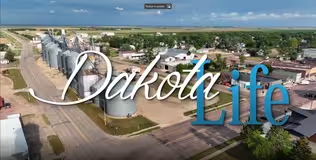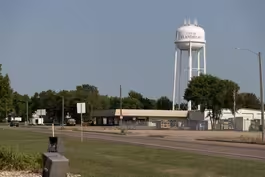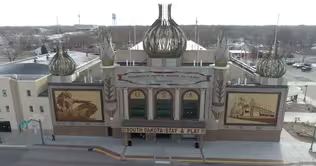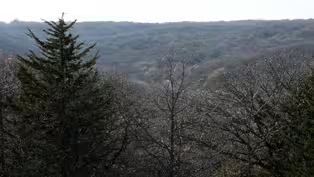Dakota Life
Greetings from Freeman
Season 23 Episode 6 | 28m 31sVideo has Closed Captions
Greetings from Freeman
Just over one thousand folks strong, Freeman graces Highway 81 in Hutchinson County. Freeman offers a swimming pool, public library, and golf course. Since 1959, Freeman has hosted the popular German celebration Schmeckfest and recently added the South Dakota Chislic Festival to its summer roster.
Problems playing video? | Closed Captioning Feedback
Problems playing video? | Closed Captioning Feedback
Dakota Life is a local public television program presented by SDPB
Support Dakota Life with a gift to the Friends of Public Broadcasting
Dakota Life
Greetings from Freeman
Season 23 Episode 6 | 28m 31sVideo has Closed Captions
Just over one thousand folks strong, Freeman graces Highway 81 in Hutchinson County. Freeman offers a swimming pool, public library, and golf course. Since 1959, Freeman has hosted the popular German celebration Schmeckfest and recently added the South Dakota Chislic Festival to its summer roster.
Problems playing video? | Closed Captioning Feedback
How to Watch Dakota Life
Dakota Life is available to stream on pbs.org and the free PBS App, available on iPhone, Apple TV, Android TV, Android smartphones, Amazon Fire TV, Amazon Fire Tablet, Roku, Samsung Smart TV, and Vizio.
Providing Support for PBS.org
Learn Moreabout PBS online sponsorshipMore from This Collection
Dakota Life stories from towns in southeast South Dakota
Greetings from Wessington Springs
Video has Closed Captions
Most cities shape the landscape they’re on, but in Wessington Springs it’s the other way around. (29m 45s)
Video has Closed Captions
Discover the beauty and history of Palisades State Park, goat yoga, and a very special love story. (29m 46s)
Video has Closed Captions
Beresford hosts the Frostbite 4, a regional favorite winter road race. (26m 26s)
Video has Closed Captions
From a window to the past to raising the next generation, Dakota Life explores Wagner. (28m 53s)
Video has Closed Captions
Greetings from Madison, the center of Lake County. (28m 55s)
Greetings from the Corn Palace
Video has Closed Captions
Greetings from the Corn Palace plus stories from southeast South Dakota and Aberdeen. (26m 16s)
Video has Closed Captions
Dakota Life showcases Newton Hills and the SD State Park system. (28m 5s)
Providing Support for PBS.org
Learn Moreabout PBS online sponsorship(upbeat music) - If you travel through the state on Highway 81 you'll see mostly a rural landscape.
But there are a few communities along the route.
And one of those towns on your drive was settled in the late 1870s by immigrants arriving in Yankton by train and continuing another 35 miles by way of wagon.
They were mostly Mennonite ethnic groups.
Germans from Russia and some Swiss.
And they settled down in the region of what's now Hutchinson County.
Welcome to Dakota Life and greetings from Freeman, South Dakota.
The ethnic heritage has been celebrated the last 62 years with Shchmeckfest and also with an annual Chislik festival.
Freeman is a thriving business community.
There are three banks, two pharmacies, two groceries and two school systems, you add in the manufacturing and the retail and residents say they're lucky to live in what they call a "big-small-town".
Well, let's start there with a look around and a look back.
(gentle music) - [Brian] The town of Freeman is located in Southeastern South Dakota in the middle of a triangle formed by Mitchell Sioux falls and Yankton.
The town's footprint is about 640 acres and the population is about 1500.
Freeman traces its founding to a small group of Germans from Russia, who traveled to the US in 1873.
Passing through New York, they heard about a place called Dakota.
They came to Yankton, the capital of Dakota Territory at the time.
They began looking for a place that might let them continue the distinctly Mennonite pacifist lifestyle they'd enjoyed in Russia for a century.
- I don't know why they stopped 35 miles North of Yankton but they did.
And they took that information back to their people in Russia and said "We have a decision to make.
There's a revolution coming.
We don't want to be part of it."
And they left.
They left the world that they had known for a hundred years.
- [Brian] So began Freeman status as a hub for Germans from Russia.
Some chose to live in colonies, like the one established at Wolf Creek.
Others chose a less insular way of life, establishing farms, businesses and soon living side-by-side with other immigrants coming from Scandinavian countries and Northern Europe.
There were two kinds of towns being established in Dakota territory during settlement days, those sided along an existing rail line, and those set up in the hope that a railroad would soon get there.
Freeman is an example of the former.
How the town came to be called Freeman isn't clear.
- Nobody knows for sure.
There's a couple of different stories.
My favorite is that the railroad, when dropping off the signs that named the town, switched Freeman and Menno by mistake.
And Freeman was supposed to be named Menno because of the large population of Mennonite immigrants that had come in 1874.
- [Brian] In January of 1888, a freakishly swift and harsh blizzard struck the Northern Great Plains and took the lives of some 235 people.
Many of them children sent home from school on what had been a pleasant day.
The Freeman area saw more than its share of loss.
The so-called Children's Blizzard was the worst event of many tough times during the settlement era.
- They were contesting with land issues, they were contesting with wildfires, prairie fires that were devastating, the weather conditions, and this went on and on and on.
And then that blizzard of 1888 hits.
And it was just like nothing has gone right up until now and then there's this.
- [Brian] But the people persevered.
They built their farms and homes and businesses.
Fred Haar's Implement Dealership was established in 1882.
It's still there today.
They built churches and of course, schools.
A private school established by the Mennonite community in 1903, emphasized teaching English and training older students as teachers.
- The decision to build South Dakota Mennonite College it would eventually become known as Freeman Junior College in the 20s and then Freeman Junior College and Freeman Academy.
And now simply Freeman Academy.
The college closed in 1986.
I believe that decision was at the milestone time in our town's history.
- [Brian] An annual fundraising event for the Academy has evolved into a very popular and long life tradition in Freeman.
Every spring, since 1959, volunteers have been cooking and serving the area's traditional ethnic food favorites family style.
Dinner is always followed by a show featuring the considerable talents of Freeman locals.
They were still going to serve dinner in 2021 in a drive-through setup, but COVID-19 has forced the cancellation of the 2021 show.
In an age where the economics of agriculture have changed so much about life in rural communities, Freeman is still doing pretty well.
- Try to figure out why Freeman has done so well for itself, because it has, and it continues to do so well.
We are hardworking people.
When we have an idea we do it.
There are countless examples of people just deciding to do something and then doing it and then doing it well.
And we've had that going for us for our entire existence.
- Freeman is on the far eastern edge of Hutchinson County.
Open prairie, greeted the first settlers to the area.
And aside from shelter belts and the James River 10 miles West, that mostly still is.
But the prairie is celebrated in Freeman.
40 acres has been transformed into the Prairie Arboretum.
It was the vision of Larry Horner who came to Freeman in 1995 as president of Freeman Academy.
He inspired others to join in like his friend Lyle Preheim.
Designs for the park were shared in 1998.
The first tree was planted a year later.
And now there are more than 500 trees and shrubs representing 150 species.
You can fish in one of the ponds, stroll along the path or attend a performance in the amphitheater.
The Arboretum enriches the lives of Freeman residents and visitors alike.
One man's dream can inspire others or be fulfilled by others.
And that's the headline.
Here's the story.
It's the story of one of the state's most successful daily newspapers (printing press whirring) (gentle music) - [Lori] When George Hunter was 56, he decided he wanted to own his own newspaper.
He sold nearly everything he owned and moved his family to Madison, South Dakota.
- Well, he was for the longest time a city editor at the port here in Times Herald in Michigan.
And so, and if you look at some old movies about newspapers he would have been cast as the gruff city editor with...
He was shouting from the editor's chair and marking up guy stuff and yelling copy and all that sort of stuff.
I'm sure it was all black and white then too, right?
(Jon laughing) You know, in those days, newsrooms were noisy places maybe even dangerous.
I mean, there were things flying around.
And so we would come down here.
I guess part of it was the excitement.
There was things, you know, happening and phones are ringing and teletype was banging.
And I don't know, there's probably a whiskey bottle in a drawer rattling around or something.
- [Lori] Times change, but the Hunter Family legacy in South Dakota news carries on.
Jon's father, Merrill Hunter took over after George's death.
Jon moved away and then home again expecting to have plenty of time with his dad to learn the family business.
It was not to be.
- It was interesting.
I think I had, you know, being a relatively young person I had to earn my own credibility.
And that's not just handed to, you know, with staff and the community and so forth.
My dad and I had planned, you know, kind of a transition period for five years or something like that.
But he unexpectedly died within a few months.
And so I was kind of here and yet not yet experienced at this job so... - [Lori] Jon Hunter was 30 when his father died and there was still a newspaper to publish.
He relied on his staff, he relied on what his father taught him.
He relied on his own instincts.
He became a publisher for a new era of newspapers but much of the daily process would be familiar to the newspaper men who came before him.
- But as far as kind of composed pages, there's nothing when we come in in the morning.
It heads back to the press room probably, let's say 1230 or one somewhere in that direction.
And then there's a lot of things that have to happen to it after that.
So you make plates and you put pages in the correct order and you get it on a printing press and it's all complete by six o'clock.
- [Lori] The Madison Daily Leader thrives with a focus on sound journalistic practices, the diverse publishing model and an indispensable eye to local coverage.
And with decades in the community, that local knowledge matters sometimes in unexpected ways.
- There was a branch of a bank located inside a grocery store in Madison.
It was robbed.
And so we got the information over the scanner and we're a Monday through Friday paper.
So the information came over the scanner beeped at about noon on Friday.
So we're at a point where we're saying, we either get this right now or you have to wait until Monday three days from now.
And so the newsroom was empty I think for lunch or something like that.
So I grabbed a pencil and raced up the street and there was a big big difference about being a staff and myself.
By then, I'd been here for a few years by then, they knew the community they knew the people involved.
And so I knew who the Bank President was.
I knew who the owner of the grocery store.
I knew the Police Chief and all those.
So I was able to quickly write up that story, take a photo rush back here, get it on the press and so forth.
And it was so fast, Lori, that we actually sell newspapers at that grocery store.
So people at the checkout line could read the story in the paper and look over the top and still see the police on the scene.
Now that's fast news... - [Lori] It's the people behind the paper who chronicle the ever evolving character of a community, who care enough about who lives here to preserve their stories.
Newspapers racing through the presses today will be folded and unfolded again around tables across the city, the state, even the country.
Readers will clip out editorials.
Grandparents will save photos and display them on refrigerators.
But for now the presses run and the reporters get ready for tomorrow's blank pages.
(loud thud) - Here in Freeman, there's another newspaper success story.
It's the Freeman Courier, serving the Freeman and Menno areas since 1901.
The weekly courier prints on Thursdays but you can get the condensed version online every Wednesday.
In the 1940s, then courier publisher J.J Mendel, advocated for a hospital in Freeman.
In 1951 they broke ground for what became Freeman Regional Hospital.
It's an independent facility serving Hutchinson McCook and Turner counties.
Well, it's been an extraordinary year for the medical facilities all across the state due to COVID-19.
When time away from work is available, we found one surgeon who trades his scrubs for a flight suit and a very unique flying passion.
(gyroplane rotors roaring) - [Brian] Dan Todd has been flying for about seven months now.
He'd never flown any kind of aircraft before May of 2020.
Flying had been a childhood dream for Todd and he always meant to learn but between earning a Medical Degree, establishing himself as an ear nose and throat surgeon and having a family, he just never found the time, until the Novel Coronavirus came along.
- When the virus came and the pandemic, our elective surgery stopped.
And so we were doing emergencies and cancer and that's about it.
So we were on call and doing cancer but I basically had like five days a week off of nothing to do.
And it couldn't work anywhere.
- [Brian] Todd started taking flying lessons in a fixed wing aircraft at the Tea airport.
But then just in the course of conversation his brother-in-law told them about gyroplanes also known as gyrocopters or autogyros.
A couple of brochures and a look at the history of gyroplanes piqued his interest.
- And then I started researching it.
And I found these guys in Missouri where I did my surgery training that were giving lessons and things at these, and then had gyroplanes and I started watching them, I go, "Oh my gosh, that's exactly what I want!"
You fly around like a bird and they don't stall.
And so I made contact with them and I was able to go down there on weekends for four or five times and just do lessons and lessons and lessons and learn how to fly this.
- [Brian] Todd bought his own gyroplane in Missouri and flew it home to Sioux falls.
He now flies out of the Tea Airport whenever he gets the chance.
Given the warm early winter of 2020 it's been almost every day.
- [Todd] And as long as you wear gloves and a coat, they're not too bad.
- [Brian] Todd likes the fact that the way the gyroplane works makes it a comparatively safe aircraft.
- Well, the rotor is a free spinning rotor.
There's no power to it.
Now there's a little bit of a hydraulic power to get it started just to get it started pre-rotated.
The old guys, they used to have these things or they have a motor and they'd have to get up there and start spinning them on their own the Benson Gyroplanes, and they'd have to spin their own rotor to get it spinning.
And then they'd go over...
This self spins.
And then the rotor kind of ends up like, as you're flying it ends up kind of catching the wind and spinning itself.
And it just picks its own speed.
And it gives you a lift, and so as long as you've got enough forward momentum, you pick a speed and just lift you up.
And so it's always on auto rotation.
And so if you're in the sky and you're 500 feet up, you can shut the engine off which I sometimes do.
And you just come down like a feather can just land cause you're always in auto rotation.
So you'll never stall, they're stall proof.
- [Brian] The tail section of a gyro plane acts as a horizontal stabilizer, basically keeping the tail down.
The rotor is really only needed to keep the aircraft in line during takeoffs and landings.
The engine and prop behind the cockpit provide the forward motion.
A hydraulic assist gets the rotor started.
Forward motion speeds it up to the point where lift is created and the plane takes off.
- You know, you can literally take off without rolling forward at all, if you're into a really strong wind.
But in general, you'd probably want a football field or something.
Two, 300 feet just to get going.
Just on a day like today, where there's no wind.
- [Brian] People who know aviation know the gyroplanes are nothing new.
The autogyro was invented in Spain in 1923 by an engineer named Juan De la Cierva, a fore-runner of the helicopter, which came along in 1935.
The auto gyro was in some ways a solution looking for a problem.
It was too slow and couldn't carry enough weight to be of much use in military settings.
The big aircraft manufacturers saw no future in it.
In 1931, someone had the idea that maybe it could serve as a mail shuttle, demonstrating its capabilities on the white house lawn.
Amelia Earhart flew a gyroplane.
The concept worked, but never found a use that made it indispensable.
The gyroplane never really went away as a hobby aircraft and a revival of sorts began in the 1980s, when a handful of companies began building and selling them.
Some fliers build their own, others build gyroplanes from kits that start at around $15,000.
These days, a new full featured gyroplane with a heated and closed cockpit can easily cost around $200,000.
As is the case with most pursuits of passion, you can start simple, but there's always another level.
(gentle music) - I'm hooked.
I mean, I just love it.
Like the guys will tell me, it's almost annoying how much I'm out here and it's pretty fun.
So yeah, I don't regret buying it at all.
And like I said, I'm looking at getting another one.
So I can fly in the cold (laughs).
(gentle music) - Gyroplanes offer a unique perspective of the ground below.
Early air travel via biplane was mostly recreational too.
At the Freeman Heritage Hall Museum, you'll see a 1927 biplane owned by the Walter family.
First to take up flying in the area.
Elvin was the eldest of three Walter sons and he was a barnstormer, making unscheduled hops and giving passengers an aerial sightseeing ride.
Elvin even earned two Pilots' License and a Federal Aircraft Mechanics' license.
Plus he logged over 1000 hours of flight in just eight years.
If you appreciate ground transportation, the museum features its selection of farm trucks, classic cars and vintage motorcycles.
And there's other displays that showcase life around Freeman.
Flight isn't the only way to be graceful in the air.
There's a new form of dance gaining popularity with two studios in the state.
It's called aerial dancing.
Once a novelty, it's becoming an artistic performance, on its own.
(upbeat music) - I love doing aerial.
It's one of my favorite things to do.
And if I've had a hard day or I'm stressed out I love just coming to the studio and being able to just talk to everyone and get on the silk and just have a really fun time.
I'd say the most difficult part is overcoming your fear of something.
Like if we learn a new drop and you're just sitting at the top and you just got to let go it's kind of hard the first time, because you're like, "Oh, can I trust the silk?
Like, will it catch me?"
Luckily we have very thick mats.
- There's a very big aerial community out there in the Midwest is South Dakota specifically.
There's two aerial silk studios.
My girls are girls from all walks of life.
And that's what I love most about our particular studio and we're like one tight-knit little family here.
I have girls that have gymnastics background and dance background, but I also have girls that have no aerial background whatsoever or no dance skills whatsoever.
They just saw it and they were intrigued and they gave it a shot.
And just like me, they're hooked.
- My mom got the idea from one of her students who had tried it out and thought it'd be fun if I did it for my birthday.
So on my 11th birthday, I went and tried it out and just instantly fell in love with it.
I really liked the Cartwheel Drop and the Star Drop.
(audience cheering) We're always learning things still, but most of the time in class is dedicated to practicing the performance, at least for me, because I want to make sure that I'm really ready for each performance.
Performing is one of my favorite things about doing aerial.
'fore I perform, I always get super nervous, also really excited.
Usually I'm pretty distracted with my routine but it's always funny to hear somebody gasp in the audience when you do a drop.
(crowd applauding) - [Saige] Cassidy has grown so much over the last two years but I think the biggest thing that stands out to me is her confidence.
But she works so hard.
She works hard.
She's very hard on herself.
So at times I definitely have to remind her that it's okay to have fun.
And it's okay to like make fun of yourself at times.
You don't have to be strong coming into it.
You will be strong eventually, we get you there.
A lot of people have their outlets.
Maybe it's running, maybe it's biking.
Maybe it's working out at the gym.
And for me, it's this.
And I know that it's the same thing here for a lot of my other girls too.
This is their time to focus on what they want to do and be themselves.
And that's what they love about it here.
- Sky Dancing Aerial Studio in Rapid City, has entertained audiences all across South Dakota.
They don't compete in aerial dancing competitions but that could be in the future as the program grows.
"Faith & the Arts" is a motto of one of Freeman's two school systems.
Freeman Academy is a private school founded in 1900 as a Junior College.
In 1986, the institution reorganized to educate students in the first through the 12th grades.
They recently added daycare, preschool and kindergarten.
The Freeman Flyers are the mascot for the public school teams.
The Public District's mission is to strive to prepare students for excellence, wherever their path takes them.
There is strong community support for both systems.
Some students receive scholarships from the Freeman Community Foundation.
Established in 1997, their work supports the economic and social wellbeing of the town.
Every demographic has benefited including a growing Spanish speaking population.
(upbeat music) - [Melissa] Emily Hofer is a third generation resident of Freeman.
Her grandparents purchased Merchant State Bank in the 1960s.
Her father later served as President and CEO of the bank.
Now Hofer is the Chief Financial Officer, a title she's held since 2005.
Having a seat in the finance industry offers a unique perspective of a community's progress.
- We get, you're involved in a lot of projects.
We can, we see family farms that just like our businesses is in a third generation.
It's fun to be part of the economic engine of a small town.
- [Melissa] Dedication to the community, isn't limited to Main Street.
Hofer is also president of the Freeman Community Foundation, a non-profit established in 1997.
- Sort of their idea of having a community savings account that would benefit the economic and social wellbeing of Freeman and made it a reality.
- [Melissa] The initial campaign generated $150,000.
Now they're just shy of a million in their endowment.
Hofer says they have awarded more than $330,000 in grants and scholarships to the community.
She says the needs reflect the changing face of the community.
- When my dad was a young child it was not uncommon to hear German spoken up and down Main Street and in the businesses.
- [Melissa] German, Swiss and Hutterite immigrants first broke ground in this region.
Farms are now becoming fewer though larger.
Freeman has become home for a growing Hispanic community.
Grant proposals reflect this changing demographic.
- In the fall of 2019.
We received a grant application for ESL instruction.
So I called the person who's in charge of that and said it's great.
I know the foundation board is going to love this application because we've never seen anything like it before.
- [Melissa] Diane Elinger and her husband came to town 50 years ago for teaching jobs and never left.
Once Elinger retired, she soon missed her classroom.
A friend suggested that she try volunteering with the English as a second language group.
- And it was a very gradual at first I just had one student.
I was really nervous but he was wonderful.
And just by word of mouth, it just grew and grew and grew in this community.
- [Melissa] Felix and Yolanda are students of Diane's.
- This is an easy question Yolanda.
Do you remember how you got connected to English classes?
- Yes, asking in the library.
- Okay.
- I was assigned tutors who teach me English.
- I think you do a very fine job.
Do you feel that you have improved your English since coming to the United States?
- Yes.
- Okay.
- My English is better.
- [Melissa] Initially the program was sponsored by the Sioux falls Literacy Council.
Support ended as the organization could no longer serve Hutchinson County.
- Some of the tutors were tutoring them in their own homes but because my class was large, larger should say we were using the library.
And I was really in a bind as far as curriculum.
I don't speak Spanish.
So I absolutely needed curriculum.
- [Melissa] ESL tutors were able to affiliate themselves with Cornerstone out of Yankton.
Freeman Community Foundation awarded the group with grant money.
- And answer these questions.
And we were able to buy technology support because much of what we do, especially now with COVID is on Zoom.
- Ben has good credentials for a job as a teacher.
- [Melissa] As teaching tools change along with the population of the community, Emily Hofer sees a bright future.
- My hope is that it, you know, is as vibrant as it is today, if not more so in the future.
- [Melissa] There's plenty of work taking place.
Recent recipients of Community Foundation Grants include updates to recreation spaces, COVID relief, placed additional burdens on outreach efforts.
The Volunteer Fire Department, Heritage Hall Museum and other organizations received support.
The ESL program purchased additional technology for the classroom and the library.
Participants are all eager to return to in-person instruction to take advantage of their investment.
- Faith is a large piece of Freeman's history and future.
Anabaptists from Switzerland and the Netherlands, persecuted in their homeland, migrated from Europe to the US in the late 1800s.
Hutterites established colonies along the James River.
Mennonite churches represent those who didn't join the colonies.
Two Hutterthall Churches are just North of Freeman, low German ethnicities from North Germany and Holland, and also Swiss German Amish lines also attend those Mennonite parishes.
The Bethel Mennonite church was established in 1892.
It was originally just East of Dolton.
The structure we're in right now was built in 1920 and it served its parish until 1992.
Come and visit Freeman for the food, for the history for the fellowship, and to be inspired by a community committed to its past and a bright future.
In the meantime, there are more stories from our travels around the state at sdpb.org/dakotalife.
Thanks for coming along.
I'm Larry Rohrer.
For all of us at SDPB, thanks for watching.
(upbeat music)
Support for PBS provided by:
Dakota Life is a local public television program presented by SDPB
Support Dakota Life with a gift to the Friends of Public Broadcasting

